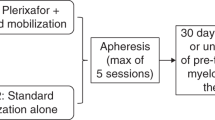Abstract
For patients with metastatic breast cancer (MBC) who undergo high-dose therapy with autologous peripheral blood progenitor cell (PBPC) transplantation, an important prerequisite is a mobilization regimen that efficiently mobilizes PBPCs while producing an effective anti-tumor effect. We prospectively evaluated ifosfamide-based chemotherapy for mobilization efficiency, toxicity and disease response in 37 patients. Patients received two cycles of the ifosfamide-based regimen; ifosfamide (5 g/m2 with conventional-dose cycle and 6 g/m2 with mobilization cycle) with either 50 mg/m2 doxorubicin (if limited prior anthracycline and/or progression more than 12 months after an anthracycline-based regimen) or 175 mg/m2 paclitaxel. For the mobilization cycle, all patients received additional G-CSF (10 μg/kg SC, daily) commencing 24 h after completion of chemotherapy. The target yield was >6 × 106 CD34+ cells/kg, sufficient to support the subsequent three cycles of high-dose therapy. The mobilization therapy was well tolerated and the peak days for peripheral blood (PB) CD34+ cells were days 10–13 with no significant differences in the PB CD34+ cells mobilization kinetics between the ifosfamide-doxorubicin vs ifosfamide-paclitaxel regimens. The median PBPC CD34+ cell content ranged from 2.9 to 4.0 × 106/kg per day during days 9–14. After a median of 3 (range 1–5) collection days, the median total CD34+ cell, CFU-GM and MNC for all 44 individual sets of collections was 9.2 × 106/kg (range 0.16–54.9), 37 × 104/kg (range 5.7–247) and 7.3 × 108/kg (range 2.1–26.1), respectively. The PBPC target yield was achieved in 35 of the 37 patients. The overall response rate for the 31 evaluable patients was 68% with 10% having progressive disease. Thirty-three patients have subsequently received high-dose therapy consisting of three planned cycles of high-dose ifosfamide, thiotepa and paclitaxel with each cycle supported with PBPCs. Rapid neutrophil and platelet recovery has been observed. Ifosfamide with G-CSF in combination with doxorubicin or paclitaxel achieves effective mobilization of PBPC and anti-tumor activity with minimal toxicity.
This is a preview of subscription content, access via your institution
Access options
Subscribe to this journal
Receive 12 print issues and online access
$259.00 per year
only $21.58 per issue
Buy this article
- Purchase on Springer Link
- Instant access to full article PDF
Prices may be subject to local taxes which are calculated during checkout
Similar content being viewed by others
Author information
Authors and Affiliations
Rights and permissions
About this article
Cite this article
Prince, H., Gardyn, J., Millward, M. et al. Ifosfamide in combination with paclitaxel or doxorubicin: regimens which effectively mobilize peripheral blood progenitor cells while demonstrating anti-tumor activity in patients with metastatic breast cancer. Bone Marrow Transplant 23, 427–435 (1999). https://doi.org/10.1038/sj.bmt.1701606
Received:
Accepted:
Published:
Issue Date:
DOI: https://doi.org/10.1038/sj.bmt.1701606
Keywords
This article is cited by
-
A phase II trial of docetaxel for peripheral blood stem cell mobilization for patients with breast cancer and ovarian cancer
Bone Marrow Transplantation (2001)
-
Docetaxel effectively mobilizes peripheral blood CD34+ cells
Bone Marrow Transplantation (2000)
-
Prospective randomized clinical trial comparing high-dose ifosfamide + GM-CSF vs high-dose cyclophosphamide + GM-CSF for blood progenitor cell mobilization
Bone Marrow Transplantation (2000)



